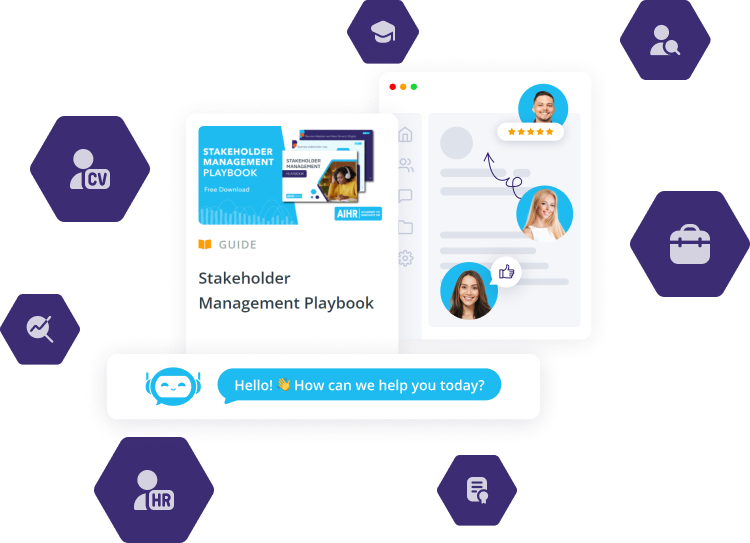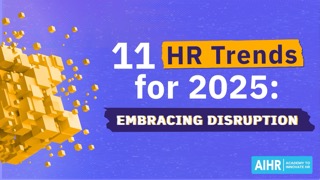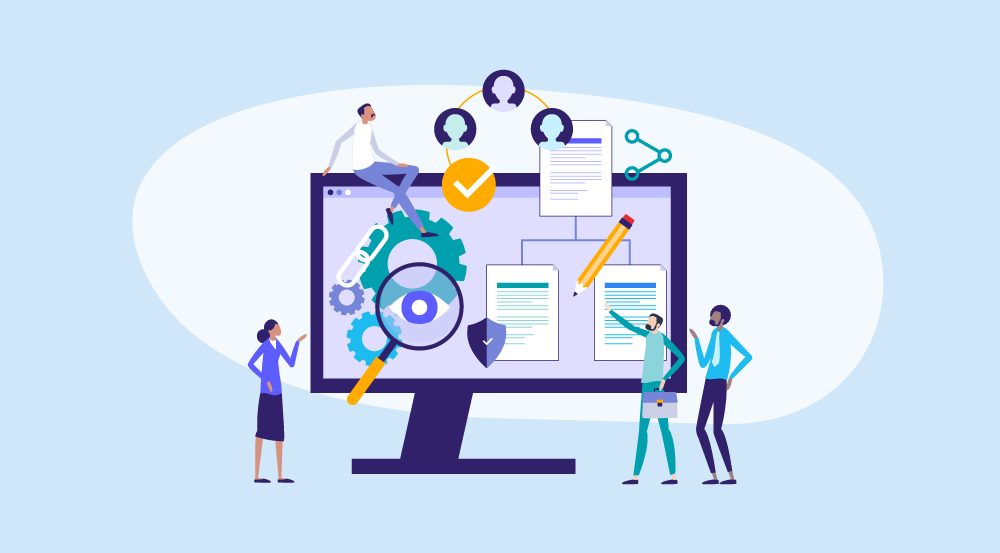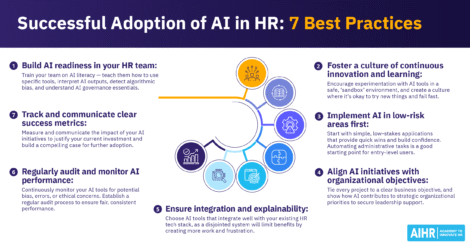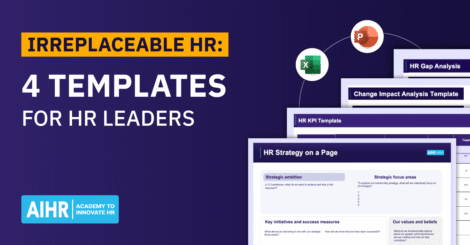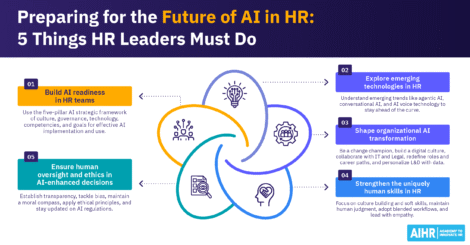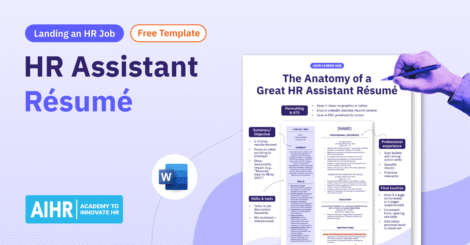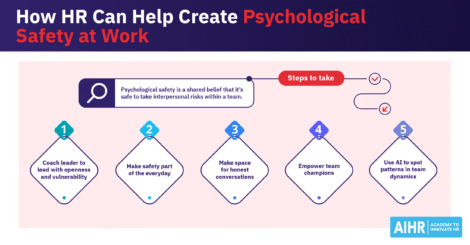HR digital transformation has become a top priority for organizations worldwide, yet many still struggle to realize its full value. A Gartner survey found that only 24% of HR functions are maximizing the business benefits of their technology investments, despite years of spending on new platforms and tools. This reveals an important truth: technology on its own is not enough. Real transformation requires rethinking how HR creates value for both the business and its people.
When done well, HR digital transformation shifts HR’s role from administrative support to strategic driver. Automation, data, and AI make it possible to enhance decision-making, improve employee experience, and build organizational agility. But transformation is not a one-time project; it’s an ongoing process. To keep pace, HR leaders need to build new capabilities, encourage continuous learning, and foster adaptability across their teams.
For those who embrace the change, the rewards are substantial: stronger talent attraction, more resilient organizations, and the confidence to navigate continuous disruption.
Let’s explore HR digital transformation within today’s HR and technology landscape, and how you can approach it successfully.
Contents
What is HR digital transformation?
Benefits of HR digital transformation
HR digital transformation challenges
Examples of HR digital transformation
HR digital transformation software solutions
The 6 stages of HR digital transformation
How to create your HR digital transformation strategy
FAQ
What is HR digital transformation?
HR digital transformation is the evolution of HR from manual, paper-based processes to digital systems and, more recently, to intelligent, data-driven, and AI-enabled ecosystems. Early efforts focused on efficiency by digitizing payroll, leave management, and recruitment workflows to save time, reduce errors, and improve the digital employee experience.
Today, digital transformation in HR is no longer a project with a clear beginning and end. It is a continuous process of adopting new technologies, redesigning workflows, and embedding digital-first thinking into all aspects of workforce management. For HR leaders, this marks a shift from simply “digitizing” to truly “transforming,” where technology becomes the basis for strategic decision-making, employee experience, and organizational agility. An essential part of this broader transformation is the rise of AI transformation in HR, where artificial intelligence moves beyond automation to fundamentally reshape how HR delivers value and drives business impact.
This ongoing transformation has significant implications for HR professionals. It requires stronger skills in data literacy, change management, and the use of emerging technologies such as AI and generative AI. Leaders must understand these tools and apply them responsibly to improve talent acquisition, performance management, and employee engagement, while addressing ethical concerns like bias and transparency.
Equally important is fostering a culture of continuous learning. In practice, this means embedding digital fluency into training, reshaping HR strategy around agility and resilience, and preparing employees for roles that increasingly combine human judgment with machine intelligence.
Digital transformation in HR goes beyond automating processes—it’s about redefining employee experience, increasing efficiency, and enabling strategic outcomes across your function.
With AIHR for Business, your HR team will:
✅ Learn how to assess and modernize HR processes with a human‑centered approach
✅ Gain practical skills in building integrated tech solutions—from HRIS to self‑service and AI tools
✅ Navigate digital change confidently with governance, capability planning, and transformation roadmaps
🎯 Move from manual to digital-first HR with a team equipped to lead transformation.
Benefits of HR digital transformation
By combining automation, data, and AI, digital transformation in HR reshapes how the function supports people, culture, and business strategy. Research from McKinsey and Deloitte consistently shows that organizations embedding digital into HR achieve stronger business outcomes, from enhanced employee experiences to more effective workforce planning.
An improved employee experience
Digital transformation in HR allows for tailored, consumer-like experiences across the employee journey. Examples include:
- Chatbots: The use of HR chatbots in recruitment, onboarding, helpdesk inquiries, and other HR processes enhances accessibility as they offer employees 24/7 access to information.
- Employee self-service: Digital HR can create all sorts of employee self-service, like helping employees manage their own leave requests and benefit plans, updating their contact details, and downloading their tax forms.
- Onboarding software: Employee onboarding software can help create a more efficient and well-structured pre- and onboarding process, hence providing a smoother experience for new hires.
- Heidelberger Druckmaschinen AG worked case: The German company worked with Deloitte Germany and Workday to unify global employee data via a cloud-based HR platform in just eleven months, resulting in faster, more consistent, and more user-friendly experiences for employees, with improved self‑service and easier access to up‑to‑date information.
Greater efficiency through streamlined HR processes
HR digital transformation boosts efficiency by reducing manual work and standardizing processes, allowing HR teams to focus on higher-value activities like advising leaders and shaping culture.
McKinsey case studies show a major bank closed its internal tech talent gap by 13% in six months and cut time-to-hire from 75 days to four weeks after digitizing its HR approach. Deloitte’s work with Heidelberger Druckmaschinen similarly created a single source of truth for employee data, improved self-service, and enabled better reporting and decision-making.
Digital tools like Applicant Tracking Systems (ATS) automate postings, track candidates, and schedule interviews, while other HR platforms streamline payroll, leave approvals, and more, reducing errors and improving overall consistency.
A more attractive employer brand
Employees today are accustomed to a seamless digital user experience in their personal lives. They have instant access to entertainment, food, news, and everything in between with one tap on their screen or a command of their voice.
They increasingly expect the same experience from their employer. As such, a smooth digital candidate and employee experience can be a valuable asset for your employer brand and help to attract talent.
Better data management and data-driven decision-making
Perhaps the most significant outcome of HR digital transformation is turning HR data into actionable business intelligence. Centralized platforms reduce silos and improve transparency, while built-in analytics allow HR to measure turnover, predict attrition, and plan succession more effectively. In this environment, data becomes a strategic driver of resilience, agility, and long-term performance rather than just a record-keeping function.
HR tip: Treat workforce data like a balance sheet
Workforce data is often underused or stuck in silos. HR leaders should manage it with the same rigor finance applies to capital and cash flow. Establish regular reporting cycles for metrics such as skills gaps, internal mobility, and attrition risk, and connect these directly to business performance discussions. By positioning workforce data as a board-level asset, HR strengthens its influence and ensures that people decisions are tied to measurable value.
HR digital transformation challenges
While digital transformation in HR offers significant benefits, it also presents challenges that can limit its effectiveness if not addressed. Common challenges include:
Unclear objectives
Digitalization must have a clear purpose that aligns with business priorities. Without it, technology investments risk becoming expensive add-ons.
Arvato Bertelsmann experienced unwanted, high turnover across several locations and wanted to address this issue. After some research into why employees left prematurely, they found that this was mainly due to a disconnect between what candidates’ expectations of the role were and the actual reality of it.
Arvato introduced a pre-employment assessment tool to address this disconnect. Candidates could take the assessment online and get a realistic job preview — a virtual peek into their future work environment and company culture. The result: Arvato’s employee turnover decreased by 63%.
HR may lack the right skills
HR is often expected to play a key role in executing the organization’s HR digital transformation roadmap. To be successful, HR professionals would need to master specific (digital) skills. However, AIHR’s research indicates that organizations of varying sizes have improved HR’s digital skills by only 7% on average over a period of four years.
Some examples of these essential skills required by HR include digital agility, HRIS knowledge, knowledge of other relevant HR software, and GenAI prompting. Change management is an additional critical skill for HR professionals to master, as employees and stakeholders will need to be guided through the transformation process.
Ethical dilemmas and misuse of AI
The introduction of legislation like the EU AI Act and the New York AI Bias law has highlighted the potential risks of using AI in HR processes. What’s more, since the advent of ChatGPT and similar generative AI solutions, employees are increasingly integrating these tools into their daily workflows.
Organizations need to develop a clear stance on using AI to avoid ethical dilemmas, productivity issues, and the misuse of generative AI and other AI technologies. At the same time, they must manage these risks so that the company can benefit from these tools.
Getting users on board
For any tool or technology to be effective, those who will use it regularly must understand its purpose and recognize its value. Without their support, your initiative is unlikely to achieve the desired outcomes.
Gallup’s State of the Global Workplace report found global employee engagement dropped to 21%, its lowest level since the pandemic. The report noted that managers are at the heart of this decline, facing major challenges integrating new digital tools and leading teams through transformation.
This highlights the importance of having a well-planned and followed change management plan and involving a knowledgeable member of the HR team or an external consultant who can effectively guide people through these transitions.
Securing sufficient resources
Implementing software or tools demands both financial and human resources. Before starting the process, securing sufficient budget and people support is crucial for an HR digital transformation to succeed.
However, this can be challenging due to potential budget constraints and difficulties in finding skilled personnel to execute the transformation. Additionally, aligning the HR digital transformation goals with the overall business strategy and getting buy-in from stakeholders can further complicate the process.
Examples of HR digital transformation
Digital transformation in HR can impact a range of HR functions, from recruitment and onboarding to payroll, benefits, and beyond. The scale of transformation varies: some initiatives can be rolled out in a matter of days, while others unfold over months or even years.
The following examples highlight different ways organizations have approached HR digital transformation.
Example 1: ATOS
Atos, a global IT and consulting firm, struggled with a disconnect between its core HR system and employee document management. To solve this, the company implemented a cloud-based solution that was rolled out across 70 countries.
The software integrated the employee file management system with the recruiting module of its HRIS, allowing for streamlined HR operations and automation of the offer letter process.
As a result, managers can now access the HRIS directly and generate an offer letter with the push of a button, eliminating the need to email HR for approval of new hires.
Example 2: Heidelberger Druckmaschinen AG
Heidelberger Druckmaschinen AG, the world’s largest manufacturer of sheet-fed offset presses, relied on fragmented, paper-based HR processes and lacked visibility into critical workforce metrics. Without a unified system, global HR reporting and personnel cost planning were nearly impossible.
To address this, Heidelberger partnered with Deloitte Germany and Workday to launch HR4Future, a cloud-based platform that consolidated data for 10,000 employees across 40 countries in just eleven months.
The platform centralizes core HR, learning, and absence management and integrates with SAP and other enterprise systems. The results include:
- Streamlined, standardized processes across all regions
- Real-time dashboards for workforce data and organizational charts
- Improved employee self-service and HR reporting
- Greater transparency, faster operations, and better collaboration across borders.
Example 3: Healthcare provider in the UK
A leading healthcare provider operated with three separate HR systems across 120 locations, creating inefficiency and inconsistency. The organization introduced a single HR platform with employee self-service capabilities and trained 120 site administrators to use it effectively.
The transformation moved all HR processes online, cut administrative costs, and gave employees tools such as remote leave booking, which saved administrators significant time each month.
Example 4: Nikkei Inc.
Nikkei Inc., a media company, faced fierce competition, shifting employee expectations, and the rise of new media formats. To adapt, the company formed a Digital Transformation Committee with HR, IT, and corporate representatives.
They partnered with Accenture to roll out Workday HCM and tools for manager use. The HR department now leverages training data to match employees with relevant programs, helping them acquire new skills or strengthen existing ones. Employees also share training insights on an internal forum, supporting peer-to-peer learning.
Through this ongoing digital transformation, Nikkei is building a workforce ready to drive future growth.
Example 5: A large South American bank
A major bank in South America faced a severe shortage of cloud and digital talent to support its shift from branch operations to a cloud-based platform. With external candidates scarce and internal resources limited, HR and technology leaders adopted a skills-first approach.
Key steps included:
- Defining the specific skills needed for cloud transformation
- Replacing role-based hiring with skills-based assessments
- Broadening talent pools to overlooked internal and external candidates
- Launching upskilling programs, with senior technologists training colleagues
- Embedding a dedicated digital recruiter in tech communities
- Integrating technology coaching into performance discussions.
The results were striking. Within six months, the internal talent gap shrank by 13%. Within a year, mid-to-senior technologist hires increased by 30%, and time-to-hire dropped from 75 days to four weeks. The HR function shifted from reactive to proactive, becoming a key driver of business transformation.
HR digital transformation software solutions
HR digital transformation software solutions are the backbone of modern HR, enabling organizations to automate processes, personalize employee experiences, and turn data into strategic insights. The right platform can make the difference between simply digitizing and truly transforming HR.
| Platform | Features | Target audience | Integration capabilities |
| Workday | AI-driven HR, finance, and planning suite; embedded analytics; task automation “agents.” | Large enterprises and global organizations. | Scalable cloud-based solution that integrates with ERP, CRM, and third-party HR tools. |
| SAP SuccessFactors | End-to-end talent management; employee experience management; strong compliance tools. | Enterprises and multinational companies. | Seamless with SAP ERP and other enterprise systems; robust API ecosystem. |
| Oracle Fusion Cloud HCM | AI-powered recruiting; workforce planning; predictive analytics; mobile-first design. | Global organizations with complex HR needs. | Deep integration with Oracle Cloud suite; connects to payroll, ERP, and industry-specific tools. |
| ADP Workforce Now | Payroll, benefits, time tracking, and talent management; AI-driven compliance alerts. | Small to mid-sized businesses; scalable for larger organizations. | Connects with ERP, accounting software, and productivity tools like QuickBooks and Microsoft 365. |
| UKG Pro (Ultimate Kronos Group) | Human capital management; advanced workforce analytics; employee experience tools. | Mid-sized to large organizations, especially in industries with complex scheduling (e.g., healthcare, manufacturing).). | Integrates with ERP, payroll, and third-party HR applications; strong workforce scheduling support. |
The 6 stages of HR digital transformation
According to research by Brian Solis for Cognizant and Altimeter, a typical digital transformation unfolds across six different stages. In HR, these stages can be described as follows:
Stage 1: Business as usual
At this stage, HR operates as if its current solutions will remain relevant indefinitely. Characteristics include:
- Limited awareness among leadership about the need for digital change
- Minimal impact of technology on HR and business processes, resulting in a fragmented HR technology landscape
- HR processes that are not yet streamlined or standardized.
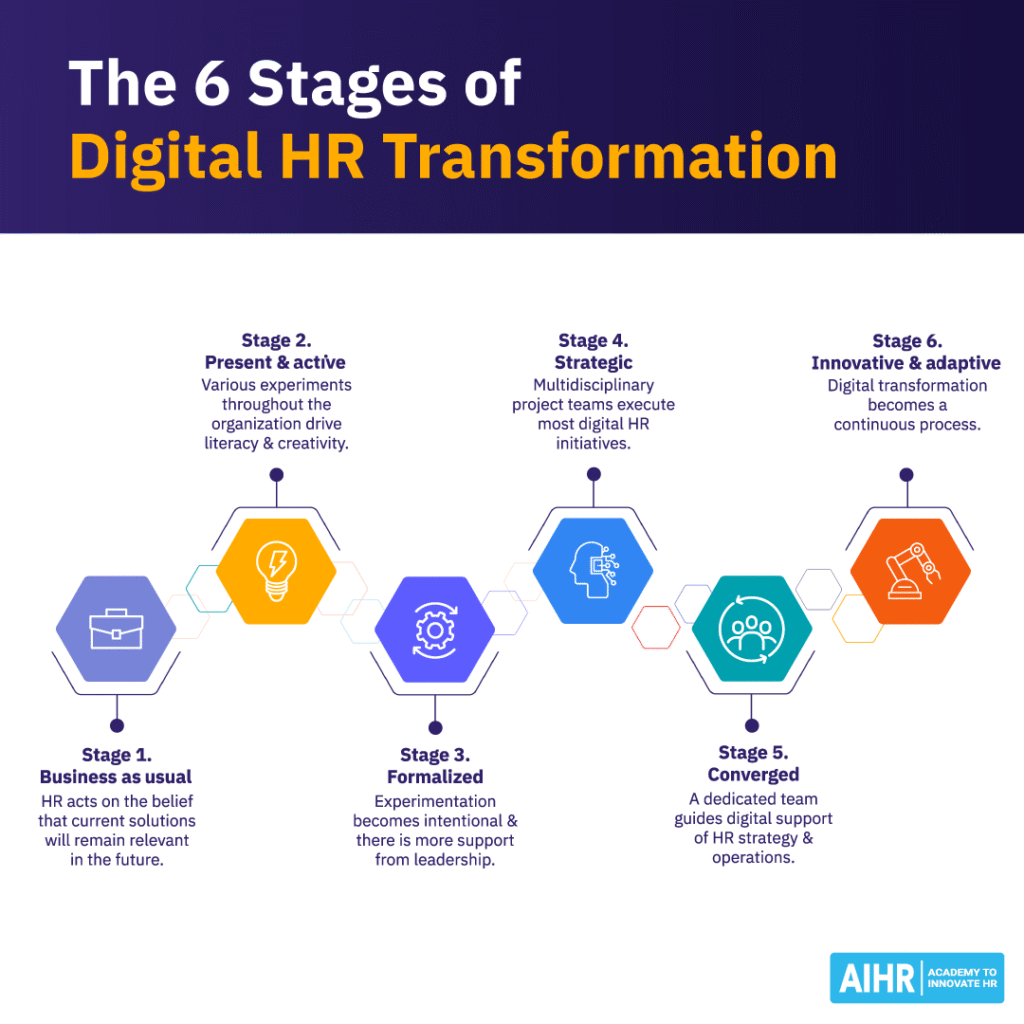
Stage 2: Present and active
In this stage, individuals or small groups begin experimenting with digital tools, sparking creativity and agility within HR. Actions often involve:
- Developing a shared vision of digital HR with organizational leaders
- Building an HR technology roadmap for the future
- Identifying key objectives for redesigning HR processes.
Stage 3: Formalized
Experimentation becomes intentional and garners more support from leadership. Important elements include:
- Gaining executive backing to secure resources for a formal digital HR strategy
- Buying or building software solutions to replace outdated systems, often with the help of an implementation partner
- Streamlining HR processes by automating or eliminating non-essential, time-consuming steps.
Stage 4: Strategic
Here, HR recognizes the power of collaboration, and most digital initiatives are executed by cross-functional teams. Typical actions include:
- Aligning the HR technology roadmap with the organization’s overall digital roadmap
- Training HR staff in design thinking and lean startup methodologies
- Embedding digital skills across HR roles and, if needed, recruiting key digital talent.
Stage 5: Converged
At this point, a dedicated digital transformation team is established to guide HR strategy and operations. Priorities include:
- Continuously aligning with broader business developments and needs
- Moving toward an integrated set of platforms and tools that are accessible to all stakeholders
- Using pulse surveys to gather employee and stakeholder feedback and optimizing processes accordingly.
Stage 6: Innovative and adaptive
Digital transformation becomes an ongoing cycle and the new “business as usual.” HR continuously innovates and adapts. Key actions include:
- Optimizing the employee experience so HR processes are seamless, or nearly invisible
- Appointing a dedicated individual or small team to drive ongoing innovation within HR.
How to create your HR digital transformation strategy
While all of this sounds great in theory, initiating the journey toward an HR digital transformation strategy can still feel daunting.
Here are a few ingredients for a successful start:
1. Evaluate your current HR processes
Before you initiate any changes, whether digital or not, it’s important to assess the current situation within the HR department.
Begin by evaluating the tools or HR software currently in use, such as an ATS and an HRIS. Create an overview of all existing HR solutions used within the company and identify whether they can communicate with each other and how they do so.
Identify the areas where digital HR can have the most significant impact. For example, implementing a digital performance management system can streamline employee evaluations and improve feedback mechanisms, leading to better talent development.
Also, investigate who is responsible for maintaining the technology, whether it is HR or IT, and whether updates occur automatically.
HR tip
Your audit will undoubtedly result in a long list of ideas of what could be improved. Prioritize these based on impact and effort. The former refers to the business impact of digitalizing the processes and the latter meaning the time and money it would take to actually bring your improvement ideas to life.
Start with the ideas that are high impact and low effort. They will help you build the business case for digital HR and get you going quickly.
2. Get stakeholders on board, define objectives & metrics
Share the outcomes of your audit and prioritization exercise with the key stakeholders in the company and use this as an opportunity to get them on board with your digital transformation plans. Examples of key stakeholders include senior management, HR leaders, IT department heads, and representatives from key business units.
Once everyone is on board, you can determine your objectives and priorities together and define success metrics. These will differ from one organization to another. Together, these priorities and metrics form the foundation for building your HR digital transformation roadmap, ensuring that your strategy is both measurable and aligned with business needs.
For example, you may want to reduce the time to hire, improve the candidate experience, and decrease new hire turnover. The following metrics could help you gauge the success of your initiative:
- Time to hire: This is one of the most well-known recruitment metrics. It measures the number of days between a candidate applying for a job and the moment that same person accepts a job offer.
- Candidate Net Promoter Score (cNPS): The cNPS indicates how likely candidates are to recommend a company based on their experience during the recruitment process. It provides HR insights into people’s overall satisfaction with the process.
- First-year attrition rate: A high turnover rate within the first year of employment can indicate inconsistencies in talent acquisition practices.
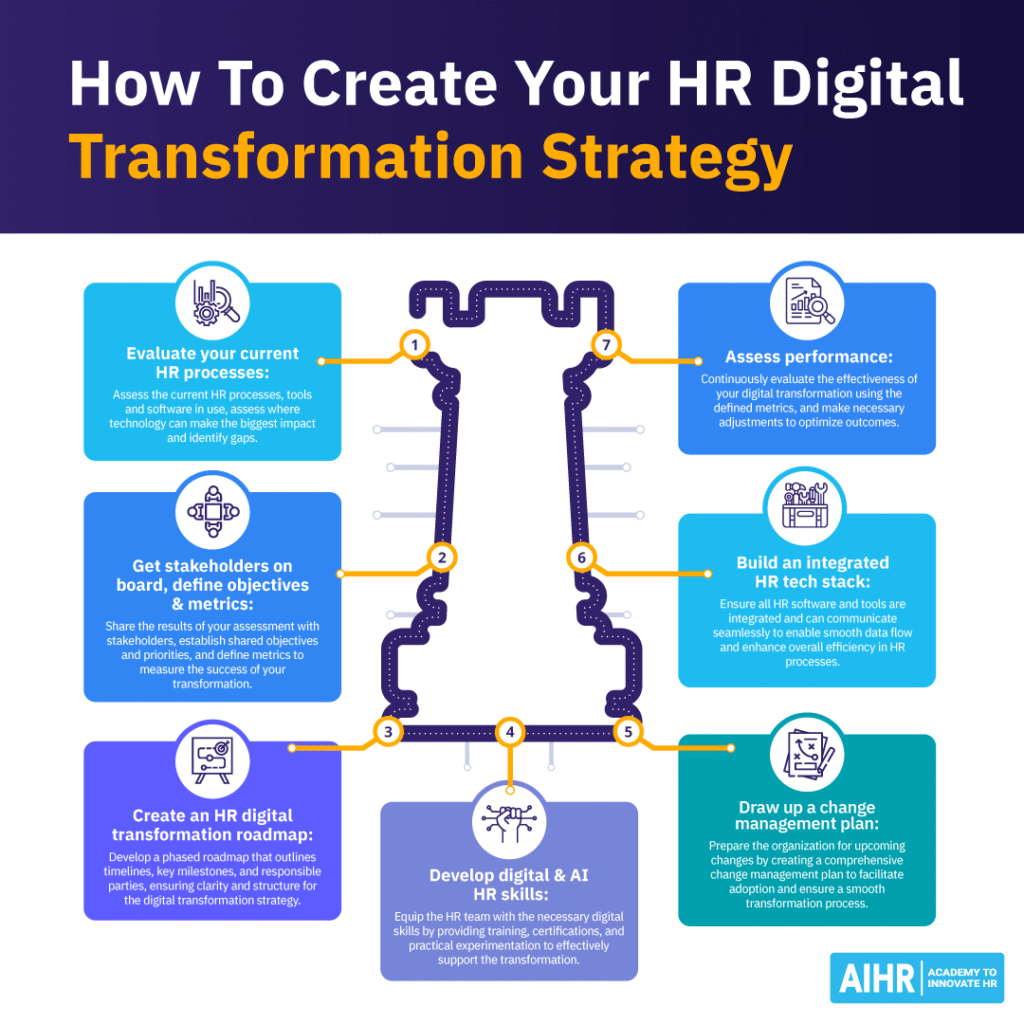
3. Create an HR digital transformation roadmap
With your priorities and objectives in mind, and in collaboration with your stakeholders, you can develop a comprehensive HR digital transformation roadmap.
The benefits of using an HR digital transformation roadmap include:
- It allows you to adopt a phased approach where you can start small, test, and refine your HR digital transformation strategy
- It enables you to plan for the potential scaling of certain HR software or tools if the organization grows
- It serves as a guide for everyone involved that outlines timelines, key milestones, and responsible parties, hence creating clarity and structure.
4. Develop digital and AI HR skills
To successfully execute your organization’s digital transformation strategy, it’s essential for at least one member of the HR team to master the necessary digital HR skills – even if you plan to collaborate with an implementation partner or external consultants throughout the process.
Start by assessing the level of digital competencies within your team (for example, through our free T-Shaped HR Assessment) and create personalized employee development plans for your HR employees to improve their skills. As part of this, focus on building AI fluency by understanding how AI works, its potential applications in HR, and how to use it responsibly. You can explore more in our AI competencies for HR teams guide.
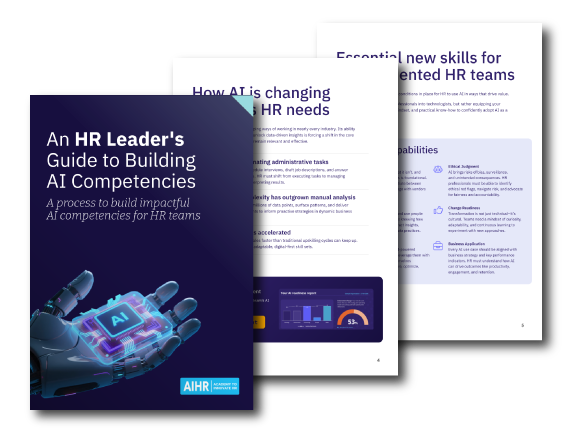
5. Draft a change management plan
Digital HR transformation has an impact on most, if not all, people in the organization. HR should create a digital change management plan to prepare everyone for upcoming changes and boost the chances of adoption and successful transformation.
6. Focus on building an integrated HR tech stack
One of the key aspects to consider when embarking on your HR digital transformation strategy is the creation of a well-integrated HR tech stack. Over time, it’s highly likely that your organization’s HR tech stack will consist of a blend of software and tools from various categories:
- Core HR solutions like HRIS and payroll software
- Recruiting tools, for example, ATS
- Employee experience software, such as learning management systems and employee engagement platforms.
You need to ensure that the various elements of your HR tech stack are integrated and can communicate with each other, allowing smooth data flow and reducing the need for manual interventions.
7. Assess performance
With the objectives and metrics established in your HR digital transformation strategy, you can critically evaluate what is effective and what isn’t. More importantly, you’ll be equipped to make timely adjustments wherever necessary.
On a final note
HR digital transformation is no longer optional for organizations that want to stay competitive, resilient, and attractive to top talent. The journey is complex and requires more than just technology; it calls for a clear strategy, new skills, and a culture that embraces change.
The leaders who act now will define HR’s role as a true business partner: one that delivers measurable value, enables agility, and creates workplaces where people and performance thrive. The next step is yours: assess where your organization stands, identify the opportunities, and take the first move toward realizing HR’s full digital potential.
FAQ
HR digital transformation is the process of automating and digitalizing existing HR processes to make them more efficient and to create a better employee experience.
Digital technology in HR refers to the integration of digital technologies into Human Resources processes to make these more connected, effective, and efficient.
The six stages of HR digital transformation are:
1) Business as usual
2) Present and active
3) Formalized
4) Strategic
5) Converged
6) Innovative and adaptive.
Before embarking on an HR digital transformation, it’s important to get a few things in order. Start with an assessment of the current HR software and tools the organization is using. Based on this assessment, you can get support from stakeholders and define objectives and metrics. Then, you can create a digital HR strategy that is laid out phase by phase in a digital transformation roadmap.
Various elements are necessary for a digital transformation to be successful, including clear objectives, HR teams equipped with the necessary skills, buy-in from everyone involved, and sufficient resources.
HR acts as both strategist and enabler, ensuring technology supports people, culture, and business goals. This includes aligning digital initiatives with workforce strategy, leading change management, building digital skills, safeguarding ethics, and using workforce data to guide decisions. In doing so, HR moves from a support role to a key driver of resilience, agility, and long-term competitiveness.


